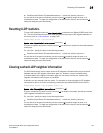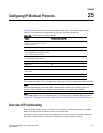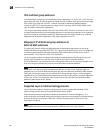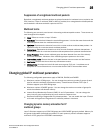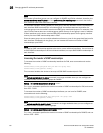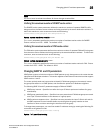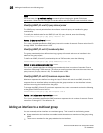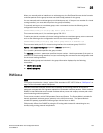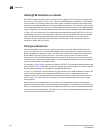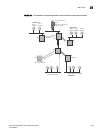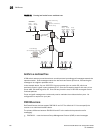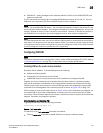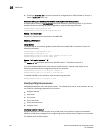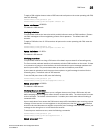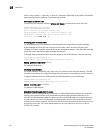
PowerConnect B-Series FCX Configuration Guide 733
53-1002266-01
PIM Dense
25
When you manually add an interface to a multicast group, the Dell PowerConnect device forwards
multicast packets for the group but does not itself accept packets for the group.
You can manually add a multicast group to individual ports only. If the port is a member of a virtual
routing interface, you must add the ports to the group individually.
To manually add a port to a multicast group, enter a command such as the following at the
configuration level for the port.
PowerConnect(config-if-1/1)#ip igmp static-group 224.2.2.2
This command adds port 1/1 to multicast group 224.2.2.2.
To add a port that is a member of a virtual routing interface to a multicast group, enter a command
such as the following at the configuration level for the virtual routing interface.
PowerConnect(config-vif-1)#ip igmp static-group 224.2.2.2 ethernet 5/2
This command adds port 5/2 in virtual routing interface 1 to multicast group 224.2.2.2.
Syntax: [no] ip igmp static-group <ip-addr> [ethernet <portnum>]
The <ip-addr> parameter specifies the group number.
The ethernet <portnum> parameter specifies the port number. Use this parameter if the port is a
member of a virtual routing interface, and you are entering this command at the configuration level
for the virtual routing interface.
Manually added groups are included in the group information displayed by the following
commands:
• show ip igmp group
• show ip pim group
PIM Dense
NOTE
This section describes the “dense” mode of PIM, described in RFC 1075. Refer to “PIM Sparse” on
page 742 for information about PIM Sparse.
PIM was introduced to simplify some of the complexity of the routing protocol at the cost of
additional overhead tied with a greater replication of forwarded multicast packets. PIM is similar to
DVMRP in that PIM builds source-routed multicast delivery trees and employs reverse path check
when forwarding multicast packets.
There are two modes in which PIM operates: Dense and Sparse. The Dense Mode is suitable for
densely populated multicast groups, primarily in the LAN environment. The Sparse Mode is
suitable for sparsely populated multicast groups with the focus on WAN.
PIM primarily differs from DVMRP by using the IP routing table instead of maintaining its own,
thereby being routing protocol independent.



